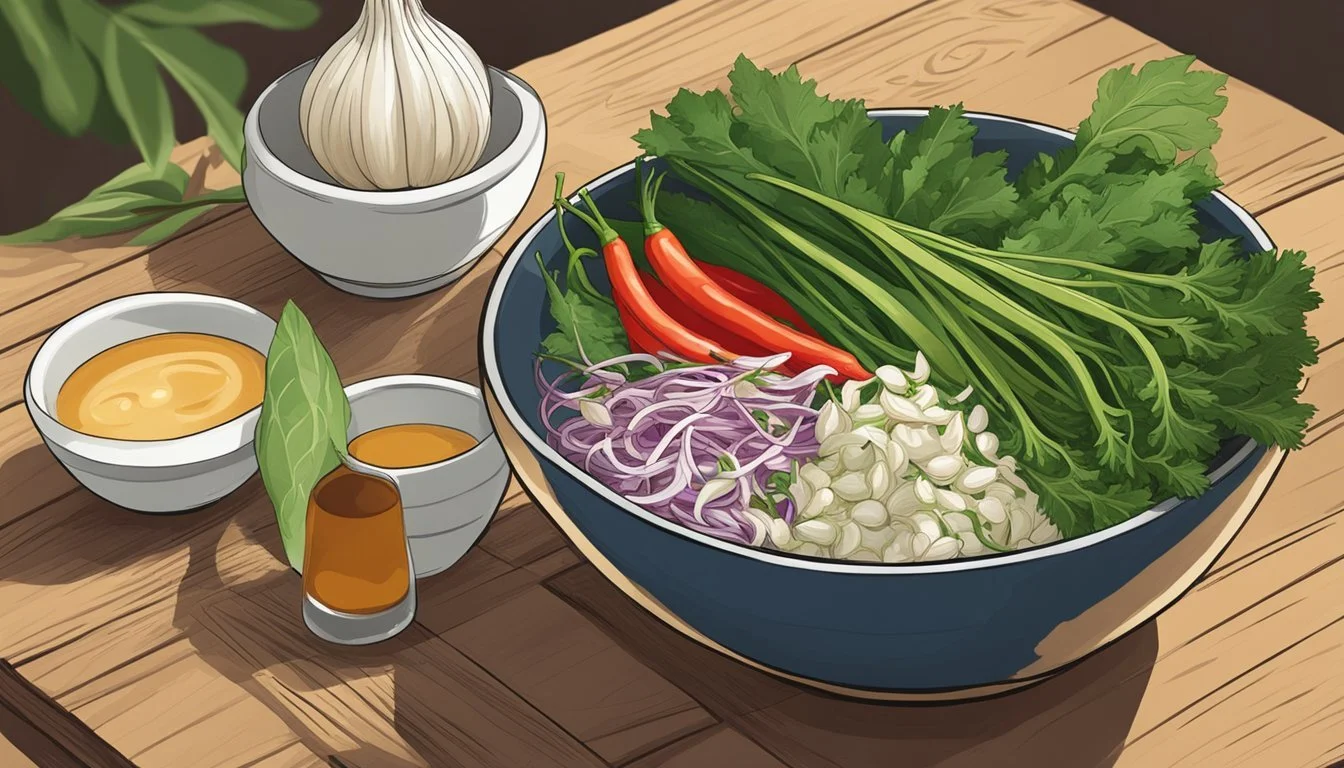Kangkong Substitutes
Best Alternatives for This Leafy Green
Kangkong, also known as water spinach, is a versatile leafy green commonly used in Filipino cuisine. Despite its popularity, it can be challenging to find in Western countries. For those looking for an alternative, spinach is the most effective substitute. Spinach, particularly baby spinach, offers a comparable texture and tenderness to kangkong, making it ideal for replicating dishes such as sinigang.
Kangkong's hollow stems and delicate leaves blend seamlessly into many Southeast Asian recipes. While it may be difficult to source, using easily accessible spinach allows for the continuation of authentic flavors without compromising on quality. Spinach provides a similarly mild taste and tender bite, ensuring that dishes remain true to their intended flavors.
Understanding Kangkong
Kangkong, also known as water spinach, is a popular leafy green vegetable in Southeast Asia. Known by various names such as ong choy, kangkung, and rau muong, this vegetable thrives in aquatic environments, earning the nickname swamp spinach or swamp cabbage.
The leaves of kangkong are arrow-shaped, giving them a distinct appearance. They are typically green and tender, making them suitable for various culinary applications. The stems are hollow and crunchy, adding a unique texture to dishes.
Kangkong is widely appreciated for its nutritional value. It's rich in vitamins, minerals, and iron, making it a nutritious addition to any diet. This vegetable is often used in stir-fries, soups, and salads.
When preparing kangkong, it's common to break off the thin stems just below the leaves and discard the tougher main stalk. The leaves and tender parts can be cooked in a variety of ways, such as sautéing, stir-frying, or simmering in flavorful sauces.
Kangkong's slightly bitter flavor mellows when cooked, making it a versatile ingredient. It's commonly paired with garlic, oyster sauce, or fish sauce to enhance its taste. In Filipino cuisine, dishes like kangkong with shrimp and kangkong and ground pork stir-fry are popular.
Due to its versatility and nutritional benefits, kangkong is a staple in many Southeast Asian kitchens. Its ability to adapt to various flavors and cooking methods makes it a beloved vegetable in both traditional and modern dishes.
Popular Kangkong Recipes
Kangkong, also known as water spinach, is a versatile vegetable in Filipino cuisine. Some of the most beloved dishes featuring kangkong include the savory Adobong Kangkong, the sour and flavorful Sinigang with Kangkong, and the spicy and aromatic Kangkong Belacan.
Adobong Kangkong
Adobong Kangkong is a popular Filipino side dish made by simmering kangkong in a mixture of soy sauce, vinegar, garlic, and bay leaves. This dish highlights the semi-sweet and salty flavors typical of Filipino culinary traditions. The cooking process involves sautéing minced garlic and onions in vegetable oil, then adding soy sauce and vinegar.
The kangkong, separated into stems and leaves, is added and cooked until tender. This simple yet flavorful dish pairs perfectly with rice and is appreciated for its rich, umami taste.
Sinigang with Kangkong
Sinigang with Kangkong is a traditional Filipino soup known for its sour and savory profile. The broth gets its tang from tamarind, which complements the natural earthiness of kangkong.
To prepare Sinigang, pork or shrimp are simmered with tomatoes, radish, and green beans, creating a hearty base. Kangkong is added towards the end of cooking to keep its vibrant green color and crunchy texture. This dish is most commonly enjoyed as a main course and showcases the balance of savory and sour flavors in Filipino cuisine.
Kangkong Belacan
Kangkong Belacan is a flavorful Malay dish made with water spinach and belacan sauce, a fermented shrimp paste. The kangkong is typically stir-fried, which enhances the vegetable’s crispiness and allows the belacan’s bold umami flavor to permeate the dish.
To make Kangkong Belacan, garlic and onions are first sautéed in cooking oil until fragrant. Belacan is then added along with chili for extra heat. Finally, the kangkong is stir-fried with this mixture. The combination of tender kangkong and savory shrimp paste makes this a standout side dish for any meal.
Nutritional Profile of Kangkong
Kangkong, also known as water spinach, is a highly nutritious leafy green.
It is particularly rich in vitamins, minerals, and antioxidants. One of the standout vitamins in kangkong is vitamin A, which supports vision and immune function.
A 100-gram serving of kangkong provides an impressive range of nutrients:
Vitamin C: 55 mg (92% of the daily recommended intake).
Iron: Vital for individuals with anemia and pregnant women.
Protein: Supports muscle repair and overall body function.
Kangkong leaves are also a good source of dietary fiber, aiding in digestion and promoting a healthy gut. Phenolic antioxidants such as carotene-ß, lutein, xanthin, and cryptoxanthin further bolster its nutritional value by combating free radicals.
Nutrient Composition per 100 grams:
Nutrient Amount Vitamin C 55 mg Protein Significant Iron High Dietary Fiber Rich
These nutrients make kangkong a beneficial addition to a balanced diet. By incorporating it into meals, individuals can enjoy both its flavor and numerous health benefits.
Selecting and Preparing Kangkong
Choosing the best kangkong and preparing it properly can significantly improve the flavor and texture of your dishes. These steps include purchasing fresh kangkong, cleaning it thoroughly, and employing suitable cooking techniques.
Buying Kangkong
When buying kangkong, look for bright green leaves without any brown spots or wilting. Fresh kangkong has crisp and firm stalks. It is commonly available in Asian markets. Avoid yellowing or limp kangkong as these indicate age and reduced nutrient content.
Stalks should be crunchy and vivid green. Check the break points of the stalks to ensure they snap easily, signaling freshness. If the leaves have a slimy texture, it's best not to purchase them.
Cleaning and Cutting
Properly cleaning kangkong is essential for both health and taste. Start by filling a basin with water and adding a teaspoon of salt. Soak the kangkong for a few minutes to remove dirt and pesticides.
Rinse under running water. For ease of cooking, cut kangkong into 2-inch sections. Separate the tender leaves from the thicker stalks. The main stalk is tough and can be discarded or finely chopped for sautéing.
Cooking Techniques
Kangkong can be cooked in various ways, including stir-frying, boiling, and blanching. Stir-frying is popular in many Asian dishes, often combining kangkong with garlic, oyster sauce, or shrimp.
Boiling and blanching are simple methods to retain nutrients. Boil kangkong for 2-3 minutes, then immediately place it in ice water to stop cooking. This method keeps the leaves vibrant and crisp.
For stir-fried kangkong, heat oil in a wok, sauté garlic until fragrant, then add the kangkong stems, followed by the leaves. Cook until tender but still slightly crisp.
Kangkong Substitute by Recipe Type
Kangkong, or water spinach, is a popular leafy green often used in various dishes. Depending on the recipe type, there are several effective substitutes that can be used in place of kangkong to maintain the desired flavor and texture.
Substitutes for Stir-Fries
In stir-fries, bok choy and Chinese spinach are excellent substitutes for kangkong. Bok choy, with its crisp stems and tender leaves, offers a similar texture and absorbs savory sauces well. Chinese spinach, similar to kangkong, has a mild flavor and retains a soft texture when cooked.
For a more peppery note, arugula can be used, though it wilts quickly, so it’s best added at the end of cooking.
Recommended Substitutes:
Bok choy
Chinese spinach
Arugula
Substitutes for Salads and Raw Preparations
When preparing salads or dishes served raw, baby spinach and watercress are suitable substitutes. Baby spinach offers a delicate texture and mild flavor that works well in fresh preparations. Watercress provides a slightly peppery taste and is rich in nutrients, adding a refreshing bite to salads.
Arugula is another good option, giving a spicy kick to raw dishes and pairing well with various dressings and toppings.
Recommended Substitutes:
Baby spinach
Watercress
Arugula
Substitutes for Soups and Stews
In soups and stews, heartier greens like kale and collard greens serve as robust alternatives to kangkong. Kale’s slightly bitter taste and firm texture hold up well in slow-cooked dishes. Collard greens, with their sturdy leaves, also maintain their integrity when simmered for longer periods.
For a more delicate substitute, spinach can be used, though it will wilt quickly and blend into the soup. Cabbage, particularly napa cabbage, can also provide a good crunch and mild flavor in soups and stews.
Recommended Substitutes:
Kale
Collard greens
Spinach
Cabbage
Incorporating Substitutes in Filipino Cuisine
Using alternative ingredients in Filipino cuisine can be a seamless process when substituting items like kangkong. Kangkong, also known as water spinach, is often used in dishes such as adobo and sinigang.
Bok Choy as a Substitute
One of the best substitutes for kangkong is bok choy. Bok choy can serve well in recipes like sinigang due to its similar texture and taste. When using bok choy in adobo, simply add it during the last few minutes of cooking to prevent overcooking.
Using Spinach
Spinach can also replace kangkong in many dishes. It has a milder flavor but cooks quickly, which is ideal for soups and stews like sinigang. In a ginisang recipe, add spinach last to maintain its vibrant green color and nutritional value.
Vinegar Adjustments
Filipino dishes often use a variety of vinegars, which can also be substituted. For example, cane vinegar or white vinegar can replace coconut vinegar. These vinegars are common in adobo recipes and can temper the overall acidity.
Tamarind Options
For a tamarind substitute in sinigang, try using lemon or lime juice. They provide the necessary sourness while maintaining the dish's integrity. Alternatively, store-bought tamarind paste can be a handy replacement.
Substitute Original Ingredient Best Used In Bok Choy Kangkong Sinigang, Adobo Spinach Kangkong Sinigang, Ginisang Cane Vinegar Coconut Vinegar Adobo, Paksiw Lemon/Lime Juice Tamarind Sinigang
Using these substitutes ensures that the essence of Filipino dishes remains intact while allowing flexibility with available ingredients. Keep in mind the cooking times and flavor profiles to achieve the best results.
The Versatility of Kangkong
Kangkong, also known as water spinach, is a popular leafy green in many Asian cuisines. Its adaptability makes it an ideal ingredient for a diverse range of dishes.
A common way to cook kangkong is by stir-frying. One can pair it with various proteins such as shrimp, chicken, or even tofu for a vegetarian or vegan option. Each combination offers a unique flavor profile.
Protein Flavor Enhancers Cooking Tips Shrimp Oyster sauce, soy sauce Fry shrimp first, then add kangkong Chicken Garlic, ginger Sauté chicken until golden, then mix in kangkong Tofu Soy sauce, spices Use firm tofu for better texture; cook separately, then combine
In vegetarian and vegan recipes, kangkong shines due to its ability to absorb flavors easily. It works well with soy sauce and a variety of spices, making it a flexible addition to any meal.
For an indulgent yet healthy dish, try kangkong with quail eggs. This meal enhances the vegetable's taste by adding a rich and smooth texture.
The versatility of kangkong lies not only in its compatibility with different ingredients but also in its simple preparation methods that suit various culinary styles.
Kangkong in Cultural Context
Kangkong, also known as water spinach, plays a significant role in the culinary and cultural practices of various Southeast Asian countries. Its use spans from traditional dishes to symbolizing wider cultural traditions and beliefs.
Kangkong in Southeast Asian Cuisine
Kangkong, also called kōng xīn cài in Mandarin and rau muong in Vietnamese, is a staple ingredient in many Southeast Asian dishes. This versatile leafy green is used in Filipino adobo, Malay kangkung belacan, Thai phak bung fai daeng, and Indonesian plecing kangkung.
Filipino cuisine typically includes kangkong in dishes like Sinigang, a sour soup, and Kangkong with Shrimp, where it is sautéed with shrimp and flavored with sauces. In Thailand, it is often stir-fried with garlic and chilies, providing a spicy and savory dish. Malay cuisine commonly incorporates kangkong in a stir-fry with shrimp paste, while Indonesian preparations add it to spicy salads.
Symbolism and Traditions
In addition to its culinary uses, kangkong holds cultural significance in various traditions. In some parts of Southeast Asia, it is believed to bring good fortune and prosperity, often used in symbolic dishes during lunar new year celebrations or family gatherings.
The ease of cultivation and rapid growth of kangkong symbolize abundance and resilience, making it a common feature in traditional agricultural practices. Additionally, it is ceremonially presented in some cultural rituals as an offering to ancestors and deities, symbolizing respect and gratitude.
This dual role of kangkong—as both a vital food source and a cultural symbol—highlights its importance across Southeast Asian societies.








